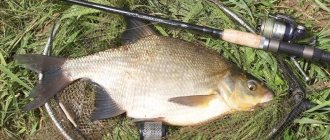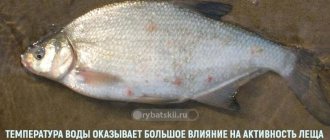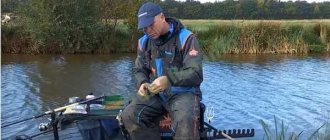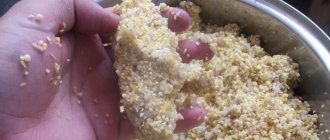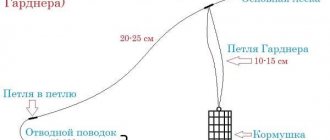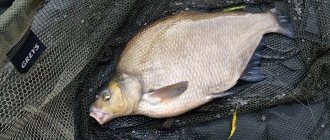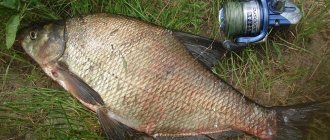Avid fishermen know how productive bream fishing can be in November. For many, this is the end of the open water season, so everyone is trying to catch their trophy. There are many ways, methods and tricks that can help you realize what you want. Much depends on the chosen gear, reservoir, bait, etc.
We hope that after reading the material, you will find new and useful information for yourself. Let's start with a detailed look at how bream fishing works in November.
Where to fish in November
With the onset of autumn cold weather, bream gather near wintering pits. At depth, fluctuations in water temperature are not so noticeable, so it is almost impossible to meet large fish in the shallows. In November, bream gathers in schools, the representatives of which are similar in size.
During this period, their joint movement and search for food was noted. Good fishing depends on the choice of place, as well as knowledge of the bottom topography, because at this time bream prefers rocky clay places with cliffs, slopes and gentle exits to the silt. If the body of water is unfamiliar, an echo sounder or a simple depth measurement comes to the rescue.
Catching bream in the fall on a feeder in September, October and November - bait, groundbait, fishing technique
Autumn fishing for bream on a feeder
Bream is a valuable commercial species of carp fish, which explains the high quality of the meat of this fish. Prefers to stay in groups. It feeds on various larvae and aquatic vegetation. Prefers deep places. In this article we will talk about autumn bream fishing, the effect of cold weather on the bite, the selection of bait and bait, and fishing techniques.
Necessary gear
In autumn, due to the gradual cooling of the water, bream stops approaching the shore during the daytime. Based on this, the most common fishing methods are feeder and ring fishing. But we will consider feeder fishing, since it does not require fishing, is sporty and is more popular among the mass of fishermen.
Feeder rod of at least 3.9 meters for long casts
The reel is inertia-free (bayrunner is optional), the only condition is a well-tuned and functioning friction brake (rear or front does not matter)
Monofilament line diameter 0.25. We recommend Salmo Feeder Specialist - this durable and practically non-stretching fishing line will allow you to effectively track all bites, make long casts due to its small thickness and not rub against stones or shells.
Hooks with a long shank to match the size of the fish’s mouth (usually No. 7-9. Should fit easily into the mouth opening.
Bream fishing depending on the month of fishing
September
In September there is a very active bream bite. Fishing on calm, clear days, especially early in the morning or late in the evening, before sunset, gives good results. In cloudy and windy weather, you can try your luck by finding a relatively calm place.
When fishing for bream, it is very useful to use fine bait, which makes it possible to keep the bream in the place necessary for the fisherman for a long time, without allowing the fish to get enough.
In September, the following perform well as bait:
Methods for planting maggots and bloodworms are described here.
The use of bait is very justified. Feed the same place every day. But to save time, you can simply fish in the same place for several days. This will definitely give a positive result.
October
In October there is a decrease in bream biting activity. This is due to the accumulation of fat before cold weather, the bream is full and feeding lasts no more than 4 hours a day.
At this time, the fish gather in schools and stay at a considerable depth, constantly moving around the reservoir.
In October, bream, as a rule, takes the bait that lies on the bottom, so the “helicopter and two knots” rig will be less appropriate. “Paternoster” or other bottom mounts will perform better.
Bait (animal components only):
The bait must necessarily contain an animal component, or better yet be based on bloodworm extract. Bream in cold water prefer food with a predominantly protein component.
November
In November, the bream bite is unstable and you have to look for it in very deep areas. You most likely won’t find it where you caught it in the summer. The pits near which it is located will be used by it in winter for wintering. The temperature in them does not drop to critically cold levels, and this allows you to endure the hardships of cold winters more calmly.
We recommend using long feeders up to 4.2 meters for long casts and fishing in pools up to 15 meters deep. To find a place you can use a marker float. or a portable shore echo sounder.
Bait - any bloodworms, maggots, but they need to be planted not in bunches, as in the summer, but in 1-2 larvae.
Groundbait - based on animal components for cold water. The easiest way is to buy it in a store; at home it is very difficult to prepare minced bloodworm. Give preference to the following brands: Dunaev, Trapper, Sensas.
Bait for autumn bream
Using bait with an animal component is a prerequisite for fishing in cold water. If in September you can get by with homemade bait with the addition of chopped worms, bloodworms, and maggots. Then in October and November, the use of the entire bait composition based on bloodworm extract becomes critical.
Fishing for carp in spring, summer and autumn - a choice of gear, bait, bait and fishing techniques all year round.
Autumn crucian carp, how to catch sluggish crucian carp - you will find out by reading the article.
Fishing technique in autumn
The most popular and effective in the fall when fishing for bream is the feeder, which is a sports bottom tackle. It is advisable to have replaceable tips available, which are used for different weights of feeders and at different flow speeds.
In a methodical approach, the autumn feeder is no different from the summer feeder. You still select a deep place by probing the bottom or using a marker float.
Then you make a starting feed based on a horizontal landmark on the other side. After the first cast, place the rod on the stand. You tighten the line by rotating the reel handle and lock the line using the clip on the spool. Now you will perform all subsequent casts at the same distance to a clearly defined point.
It is necessary to make at least 10 bait casts in order to properly feed the place. Only then attach a leash with a hook, attach the bait and fish according to the rule of waiting 10 minutes. Bream is passive in the fall, so three-minute transfers of gear, which were relevant in the summer, are now too fast.
Autumn bream fishing has its own seasonal characteristics:
- To get an excellent catch, you need to choose the right place where the school of bream is grouped.
- When fishing in autumn, the most effective gear is a feeder, which allows you to fish at significant depths.
- A good effect is obtained when used with the addition of animal components - worms, maggots, bloodworms or based on animal extract of bloodworms, we recommend brands: Dunaev, Trapper, Sensas for cold water.
- Once again, the best baits in the fall are: bloodworms, maggots, and worms. And the closer to winter, the fewer larvae on the hook should be.
With the correct selection of all components, the result of fishing will be a wonderful catch of excellent fish - bream.
What to fish with from the shore
The determining factor in choosing gear is the distance to the desired depth. There are reservoirs with cliffs not far from the shore, then you can try a float rod; if the intended casting point is located at a distance, a feeder will do.
Expert opinion
Valery Andreevich Sizov
Professional fisherman with 35 years of experience
Remember that the length of the rod affects the casting distance.
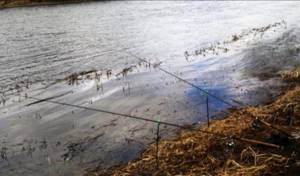
General requirements for feeders
With the expectation of a large specimen that will not give up without a fight, durable fishing rods are selected. The length, which can be from 3 to 4 meters, is better to choose carbon fiber ones, the test can range from 40 to 150 g, it depends on the current. In still water there is a smaller test, with a strong current - a larger one.
For the feeder, select a slow-moving, moderate-power reel with a bullet that holds 150 m of line. The type of clutch doesn't really matter, the main thing is that it works.
Choose a good quality fishing line with a cross section of 0.2 - 2.5 mm; non-stretch or fluorocarbon Salmo is suitable; it is not expensive, but durable. You can use braid from 0.12 mm, but at minus temperatures it freezes, and when wet it hides the casting.
The weight and type of feeders depends on the fishing conditions. When casting long distances, the “bullet” works well, but it is tossed around by a strong current, so oval ones are best used in calm water. On the lake, use feeders without a bottom or with large holes; they work better. In a strong current, put it heavier - 110 - 130 g, it won’t blow away when diving.
Fans of feeder bream fishing are advised to watch the video:
There are no specific installation requirements. Each fisherman uses his own favorite method, it could be a helicopter, a symmetrical loop, etc.
A hook is attached to a reliable leash line, the sizes of which range from No6 to No12.
Expert opinion
Valery Andreevich Sizov
Professional fisherman with 35 years of experience
Advice!
As practice shows, November bream prefers bait on a smaller hook.Important! The length of the leash depends on the reservoir, it is better to prepare several from 40 cm to 1.20 m. Keep in mind that the transparency of the water, the feeder lying on the bottom should not scare the fish and ready-made leashes will save time in case of a line break.
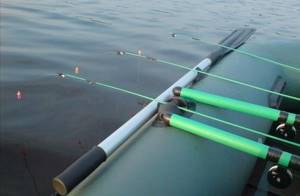
What to fish with from a boat
The most convenient tackle for a boat is a side fishing rod with a nod. Complementary feeding of the area is done separately; for this purpose, balls rolled from porridge or mixture are lowered into the water. Feed nets are also widely used. To do this, place the bait in a fabric with holes, tie a good weight, attach a strong fishing line to the boat and weight and lower it into the water. Remove and add contents as needed. But you shouldn’t do this during the bite, you can waste time and the school will move away or scare a potential trophy.
Expert opinion
Valery Andreevich Sizov
Professional fisherman with 35 years of experience
On rivers, fishing for bream from a boat follows the current.
They equip the onboard fishing rod with a blind or sliding weight; more often they use a shortened olive or a ball. Winter equipment with a jig has also proven itself well on lakes. When fishing from a boat, you can use a couple of rods; it is better to take them with foam handles, in which case they do not sink and do not threaten to be left without gear.
They can be equipped in different ways, for example: put one with a sinker and a hook; the other with a jig. You never know what bream might want at the moment. Keep in mind that for a good line slack of 0.2 mm, you need to take a jig weighing more than 3 g - this will help you better see whether the bream is biting. Use a soft nod on this rod.
The shape of the jig can be different:
- for the game, choose sickle-shaped or “Uralka”;
- When motionless, flattened views work better.
Color plays an important role; in November bream takes well on dark jigs without shine or brightness, for example on:
- black;
- dark gray;
- dark brown.
Many boat fishermen use float rods in still water. Considering the weather conditions, possible wind and waves, it is not always clear whether the fish are biting, so it is quite possible to be left without prey.
Catching bream on a feeder in autumn
It's getting colder, and catching bream is becoming more and more difficult. But if there is fish, then it cannot help but eat.
And the fisherman’s task is simple - to understand what needs to be done to make the fish bite. Each of my fishing trips on a new body of water begins with a complete lack of bites, and then comes an understanding of why the fish were not active. And the reasons for this are usually banal - the color of the bait, the wrong point, the wrong attachment.
That’s why I wanted to share my observations about the difficult task of catching bream with a feeder in cold water.
Bream fishing conditions
The Dnieper waters are a very sporty bream reservoir , especially in the fall, when these wide-bodied fish gather in large schools before wintering and, fattening up, make fishing interesting and memorable.
The success of any feeder fishing often largely depends on the correct choice of fishing point. In the fall, such a point plays an even more important role, since the fish, having “dug in” at a certain distance, stubbornly stays there, rarely changing its position even when the distance to the feeding table with maggots and bloodworms set by the fisherman is measured by several meters.
Finding a place to catch bream
In autumn, you should look for bream at the maximum possible depth. But the fish will not just stand on a clean bottom - bream are attracted to bottom anomalies like a magnet. Usually, they choose narrow grooves overgrown with shells as their anchorage or temporary shelter. Therefore, in order to find a promising point, it is necessary to carefully measure the bottom.
It often happens that you do everything right, but the fish simply aren’t there. In this case, you should forget for a while the main dogma of the feeder - to fish from one point. If everything is very sad, I put the most food-intensive feeder, fill it tightly with bait and throw it as far as possible.
After which, every half a minute, I pull the rig to the shore. If I find a distance at which bites occur, I make sure to fix it and make a starting feed with a large amount of animal content. This allows you to collect fish scattered along the edge at one point.
Features of bait
The low temperature of autumn water forces the use of dark bait mixtures. For cold water fishing, I have developed a simple recipe - a mixture of ready-made Fish Dream baits “Bream”, “Sport Black” and “Dark Biscuit”, one kilogram each. Three kilograms of bait is more than enough for five hours of fishing in such conditions.
But you need to remember that you should definitely add soil to the moistened bait mixture, since the soil in the bait, especially in the fall, prevents the bream from gorging on the plant mixture. In this case, the soil can be mixed with bait even in a one to one ratio. If we talk about the weaknesses of autumn bream, then it is certainly bloodworms.
Small red larvae speed up the work of the plant mixture and allow you to keep bream on bait for a long time.
Favorite bream baits
The choice of bait directly depends on which living component dominates in the bait. If there are a lot of bloodworms in the bait, then large bloodworms should be served as bait for the fish. Quite often, various combinations of maggot and red grub work great.
Also, do not forget about such bait as worms. After all, if in the fishing area there are a lot of small fish in addition to bream, a large bunch of red worms will certainly give you the opportunity to wait for a bite from a larger fish.
With all this, a large bait often turns out to be unclaimed, so it is worth remembering such combinations as two moths in a ring, one moth in a stocking, etc.
Thin Snaps
Considering the changeable and often windy weather, it is necessary to use heavy feeders and powerful rods, because otherwise, it is difficult to fish from a long distance on the Dnieper current. At the same time, the passivity and caution of the fish force them to make sacrifices and use thin leashes. It is very important to find the right ratio between the number of fish lost, the total number of bites and the optimal thickness of the leader. Usually in difficult conditions it is necessary to use leads with a diameter of 0.1 mm. Having tried many fishing lines, I finally settled on Smart SLR. Amazing softness and strength with thin diameters make, in my opinion, this line the best for making leashes. This is confirmed by a bream weighing more than one and a half kilograms, caught on a 0.08 mm SLR leash at the traditional competition - “Spring Roach 2010”.
Bream fishing tactics
To catch bream at any time of the year, you should feed them generously. And since such fishing often takes place at a considerable distance from the shore, you need not to be lazy and be sure to spend time on starting feeding. After all, the further away the fishing point is, the more smeared the feeding spot will be. For this very reason, fish may not immediately respond to bait. But if everything is done correctly, the result will not take long to arrive.
And if suddenly something doesn’t work out for you the first time, don’t blame it on the bait , fishing rod, wrong hooks - after all, gear only helps us outwit the fish, and the main success lies in understanding what we do to achieve the result. Good luck and perseverance to you!
Catching bream on a feeder in autumn
Source: https://handf.mirtesen.ru/blog/43061347990
Baits and their quantity
With the onset of cold weather, you should reduce the amount of bait and change its quality. At the end of autumn, it is difficult to keep the bream in one place with food; it will linger if it is interested in this part of the reservoir. Therefore the principle is:
- on lakes, fine fractions are mixed with soil;
- on the flow of porridge, soil and large fractions.
On rivers, boiled pearl barley shows good results; it can be safely stuffed into feeder feeders and hooked to a worm. It washes out slowly, while forming an attractive cloud.
Expert opinion
Valery Andreevich Sizov
Professional fisherman with 35 years of experience
The smell of the bait should be neutral, the color without bright inclusions, such food should be darkened. Remember, bream loves bread and adding crackers or pieces of cookies will only be a plus.
Baits
Bream tastes more like winter in November, so use soft baits. Experienced fishermen during this period refuse worms or use them as bait. When fishing from a boat with an onboard rod in November, summer options still work well:
- pearl barley;
- bread.
A sandwich with the addition of bloodworms wouldn’t go amiss. With feeder gear, the fisherman is more limited in the choice of bait, since when casting, soft pearl barley and a ball of bread simply fly away. Therefore, feel free to wear a tied bunch of bloodworms or a couple of maggots and bloodworms.
Expert opinion
Valery Andreevich Sizov
Professional fisherman with 35 years of experience
Advice! Use several tackles at once, this will not only increase the likelihood of catching a trophy, but also experiment with bait.
Important! If the feeders are placed at a distance from each other, when biting on one tackle, place the other closer to the biting spot.
Bream in autumn
Published: 11/01/2012
The most favorable time for catching bream is summer. Its good bite begins after spawning and rest - from mid-June, and continues in warm water until mid-August or early September.
At this time, bream are most active, respond well to bait and are caught at almost any time of the day. But as the weather gets colder, their bite subsides, becomes more and more capricious, and at times stops altogether. But I want to catch! And at any time of the year.
Moreover, autumn has many advantages when it comes to fishing.
Often the weather in September and October can be simply wonderful, there are no mosquitoes, unusual colors of autumn foliage are everywhere - how can you resist and not go fishing? Doesn't bite well? No problem! In winter, the bite will be even worse, but now it is quite possible to catch bream, or at least bream. Moreover, below we will discuss the features of autumn bream fishing.
Beginning of autumn
Depending on the region, the temperature at this time can be almost “summer” and the fish behave actively, or it can already “smell like winter”; bream at such times combines periods of intense biting with complete indifference to the bait.
If the air temperature is still above 20 degrees, then bream can be found in almost any part of the reservoir. Feeder lovers most often, after examining the bottom, try to fish in places with differences in depth, edges, and holes.
But in summer and early autumn, you can also look for bream on the borders with reeds, on shallows and near overgrown islands. With the help of bait, fish can be collected at this time in almost any area. When the water is still warm, bream is active and most of the time moves around the reservoir in search of food.
By choosing the optimal bait and attachment, you can keep a group of bream in place, while not forgetting to deliver new portions of bait.
The composition of bait for feeder fishing at this time does not differ from the standard mixtures that we are accustomed to in the summer. In the summer, and especially in the fall, it is worth adding maggots to the bait, and if funds allow, then bloodworms.
Moreover, experienced fishermen spend at least half a liter of maggots and bloodworms (as they say: “You can’t spoil porridge with butter”) for five kilograms of dry bait, plus millet or boiled peas. Moreover, the rule that “what we catch with must be present in the bait” does not always work. Bloodworms with moths should always be added, and especially in the fall, when the bream begins to sort through the proposed bait.
Another thing: “Will there be enough money for such a supplement?” Well, this is already a trivial question. If possible, then live components should be added, and the more, the better.
Large bream, and by modern standards these are individuals from 30 centimeters, loves to eat, but you can’t keep it in place with just porridge.
The fish feels that the “holiday” of summer days is coming to an end and tries to choose food rich in protein, and these are, first of all, larvae, worms, mollusks, etc. There is another option to add scalded maggots to the bait, and use normal ones on the hook.
Some believe that such a moving bait attracts attention better, and the scalded maggots in the bait do not spread and keep the bream on the “spot”.
For many feeder anglers, maggot is the best bait for bream at any time. These larvae work all autumn, but you can experiment with placing a dung worm, large bloodworm on a hook and combining them with each other. You can forget about barley, corn, and pasta until next summer.
Mid and late autumn
As the weather gets colder, the diet of all fish, including bream, changes. It begins to feed less frequently, moves around the pond less, gathers in large groups, and then in flocks. When the water temperature becomes 10-15 degrees, then during the day only bream bites, and large bream are very difficult to find.
On some reservoirs, the night hunt for bream begins, on others it can only be found during the day above the pits or in the pits themselves, and the bite, if there is any, can be completely “cut off” after a couple of hours.
And at the same time, due to the active predator and clear water, the bream is very timid and often the school leaves the feeding place after catching a large specimen or completely stops feeding.
In the cool time of autumn, the main thing is to find bream and then feed it (it is better to use winter bait for bream at this time). White fish and bream will be caught, but it’s difficult to catch “humpbacks”. You need to look for large bream.
For example, with two feeders you can simultaneously fish edges at different distances or a hole. If there is no normal bite for an hour or two, then it is better to move to another place altogether. Knowledge of the reservoir, where the holes and walk-through edges are located, will help here.
From year to year, the behavior of the fish can be repeated, and observing them and systematically recording them will help you find bream.
A separate topic is night autumn bream fishing. As the air temperature drops to 0...+5 degrees, the bream begins to move - within several hours of the night, the fish literally grabs everything it finds on the hook. This is where preliminary evening feeding of a selected, preferably known, promising point and waiting will help.
Again, you need to look around the reservoir, where the bream feeds intensively at night, on the shore you can find night illumination from flashlights and fireflies for fishing.
One night you can really catch a lot, but on others you won’t see a bite of a normal bream at all until the morning, when small bream and other “bream” will already begin to take.
Let's focus separately on flavorings. It is generally accepted that in cold weather their addition is reduced to a minimum. This recommendation can be found in many articles and films, but I beg to differ.
When the water temperature becomes 10 degrees and below, you need to use alcohol flavors rather than oil ones, but they should still be added. You just need to choose more “winter” scents or a combination of different scents.
In some reservoirs, at this time, cocoa and molasses flavors work well for bream and white fish.
We also recommend a useful video on the topic in question:
Read interesting articles:
Hooks for bream - selecting the optimal size and shape of the hook
Catching river bream in summer, on a feeder - features of summer fishing
Source: https://feederist.ru/stati-i-rekomendacii/123-lew-osenju
Biting time in November
Try to arrive at the pond with plenty of time to decide on a place, launch the boat and settle in. Provide a small feeding of the area. Distribute gear. Usually bream starts biting from 10 a.m. until lunchtime, but a lot depends on the weather. After all, unstable atmospheric pressure and gusty winds at this time of year will not surprise anyone, and fish do not like such weather. She behaves passively and does not bite; experienced fishermen say that she is “sick.” The best condition for catching bream in November is stability and even if the days are not sunny, there are no changes.
The end of the open water season was a time of triumph for many fishermen and allowed them to boast of a stocked cage. If you are not one of the lucky ones, don’t worry, it means that your November bream has not yet gained a lot of fat and weight.
If you liked the article and now you know exactly how bream fishing works in November, share your opinion in the comment.


